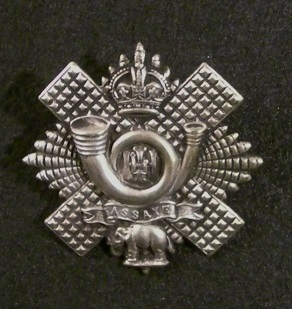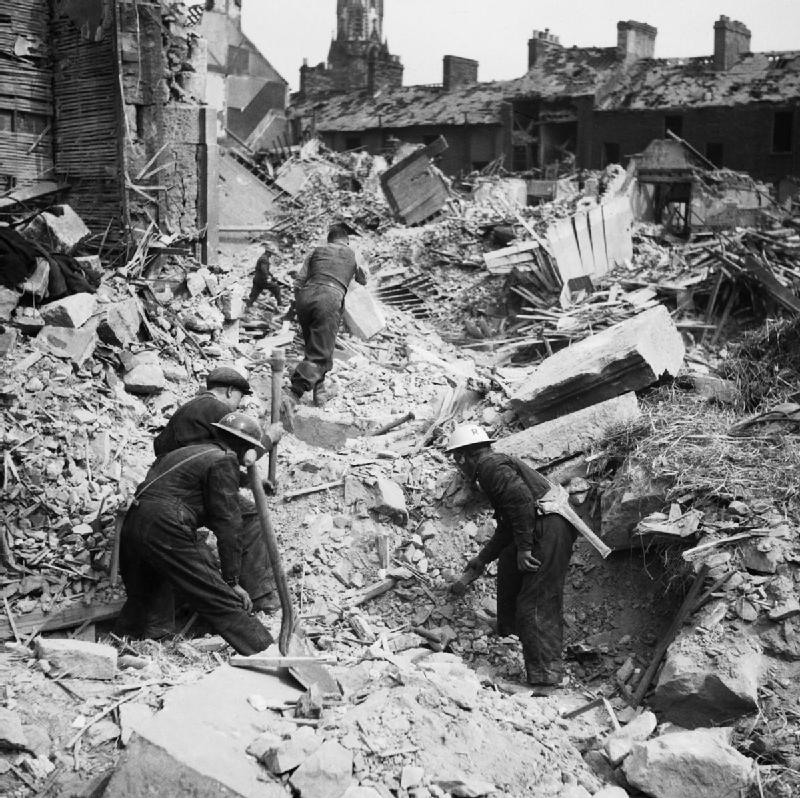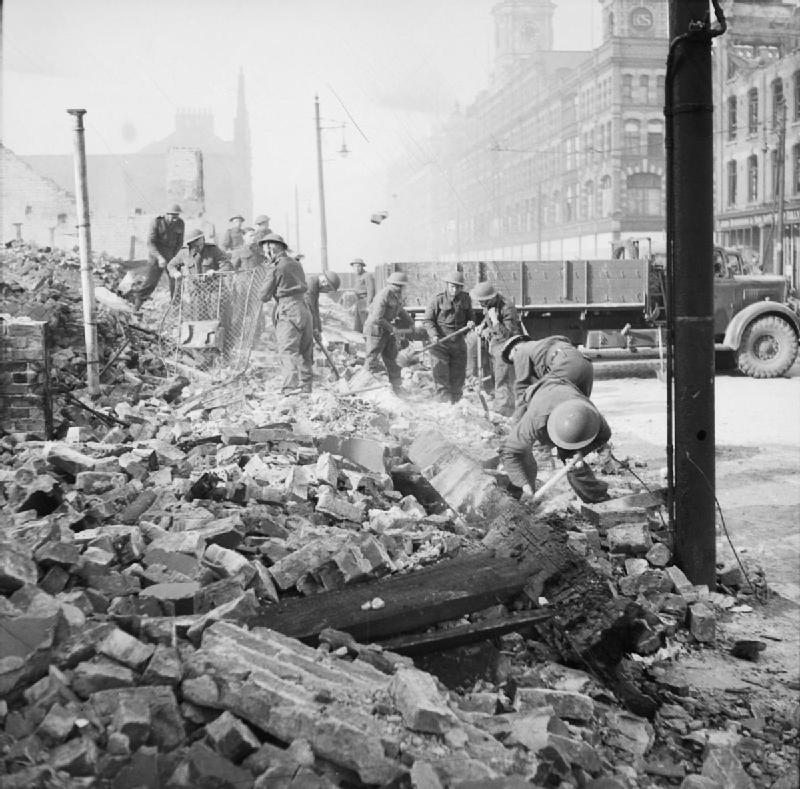|
12th Anti-Aircraft Division (United Kingdom)
12th Anti-Aircraft Division (12th AA Division) was an air defence formation of the British Army during the early years of the Second World War. It defended Western Scotland and Northern Ireland, including the period of the Clydebank Blitz and Belfast Blitz, but only had a short career. Mobilisation The 12th Anti-Aircraft Division was one of five new divisions created on 1 November 1940 by Anti-Aircraft Command to control the expanding anti-aircraft (AA) defences of the United Kingdom. The division was formed by separating responsibility for Western Scotland (particularly the industrial areas of Clydeside and Ayrshire) and Northern Ireland from the existing 3rd AA Division, which continued to be responsible for the rest of mainland Scotland.Routledge, p. 394; Map 34.Frederick, p. 1047. The divisional headquarters (HQ) was at Glasgow and the General Officer Commanding (GOC), appointed on 15 November 1940, was Major-General Gerald Rickards, promoted from command of 44th AA Brigade ... [...More Info...] [...Related Items...] OR: [Wikipedia] [Google] [Baidu] |
Divisional Insignia Of The British Army
Formation signs at the division level were first introduced in the British Army in the First World War. They were intended (initially) as a security measure to avoid displaying the division's designation in the clear. They were used on vehicles, sign posts and notice boards and were increasingly, but not universally, worn on uniform as the War progressed. Discontinued by the regular army after 1918, only a few Territorial divisions continued to wear them before 1939. Reintroduced officially in late 1940 in the Second World War, divisional formation signs were much more prevalent on uniforms and were taken up by many other formations, independent brigades, corps, armies, overseas and home commands, military districts and lines of communication areas. The sign could be based on many things, geometry (simple or more complex), heraldry, regional or historical associations, a pun, the role of the division or a combination. First World War Until 1916, unit names were written on vehicl ... [...More Info...] [...Related Items...] OR: [Wikipedia] [Google] [Baidu] |
Luftwaffe
The ''Luftwaffe'' () was the aerial-warfare branch of the German ''Wehrmacht'' before and during World War II. Germany's military air arms during World War I, the ''Luftstreitkräfte'' of the Imperial Army and the '' Marine-Fliegerabteilung'' of the Imperial Navy, had been disbanded in May 1920 in accordance with the terms of the 1919 Treaty of Versailles which banned Germany from having any air force. During the interwar period, German pilots were trained secretly in violation of the treaty at Lipetsk Air Base in the Soviet Union. With the rise of the Nazi Party and the repudiation of the Versailles Treaty, the ''Luftwaffe''s existence was publicly acknowledged on 26 February 1935, just over two weeks before open defiance of the Versailles Treaty through German rearmament and conscription would be announced on 16 March. The Condor Legion, a ''Luftwaffe'' detachment sent to aid Nationalist forces in the Spanish Civil War, provided the force with a valuable testing grou ... [...More Info...] [...Related Items...] OR: [Wikipedia] [Google] [Baidu] |
123rd Heavy Anti-Aircraft Regiment, Royal Artillery
1 (one, unit, unity) is a number representing a single or the only entity. 1 is also a numerical digit and represents a single unit of counting or measurement. For example, a line segment of ''unit length'' is a line segment of length 1. In conventions of sign where zero is considered neither positive nor negative, 1 is the first and smallest positive integer. It is also sometimes considered the first of the infinite sequence of natural numbers, followed by 2, although by other definitions 1 is the second natural number, following 0. The fundamental mathematical property of 1 is to be a multiplicative identity, meaning that any number multiplied by 1 equals the same number. Most if not all properties of 1 can be deduced from this. In advanced mathematics, a multiplicative identity is often denoted 1, even if it is not a number. 1 is by convention not considered a prime number; this was not universally accepted until the mid-20th century. Additionally, 1 is the s ... [...More Info...] [...Related Items...] OR: [Wikipedia] [Google] [Baidu] |
111th Heavy Anti-Aircraft Regiment, Royal Artillery
111th may refer to: * 111th Delaware General Assembly, a meeting of the legislative branch of the state government * 111th Engineer Brigade (United States), a combat engineer brigade of the United States Army * 111th Field Artillery Regiment (United States), a 155MM towed artillery unit with a General Support/Reinforcing mission * 111th Fighter Escadrille (Poland) of the Polish Air Force, a fighter unit of the Polish Army * 111th Fighter Wing, an Air National Guard fighter unit located at NAS Willow Grove, Pennsylvania * 111th Indian Infantry Brigade, an Infantry formation of the Indian Army during World War II *111th Infantry Brigade (Pakistan), an infantry brigade of the Pakistan Army * 111th Infantry Division (German Empire), a unit of the Imperial German Army in World War I * 111th Infantry Regiment (United States), represented in the U.S. Army by 1st Battalion, 111th Infantry *111th Maneuver Enhancement Brigade (United States), an air defense artillery brigade of the United Stat ... [...More Info...] [...Related Items...] OR: [Wikipedia] [Google] [Baidu] |
100th Heavy Anti-Aircraft Regiment, Royal Artillery
100th Heavy Anti-Aircraft Regiment, Royal Artillery, was a Scottish air defence unit of Britain's Territorial Army (TA) formed at Motherwell during the period of international tension leading up to the outbreak of World War II. It defended Glasgow during the early part of the war and then took part in the assault landings in Sicily (Operation Husky) and on mainland Italy (Operation Avalanche). The regiment continued in the postwar TA until amalgamated in 1950. Origin The Territorial Army was rapidly expanded following the Munich Crisis, particularly the Anti-Aircraft (AA) branch of the Royal Artillery (RA). 100th Anti-Aircraft Regiment, RA was among the new units raised in the Spring of 1939: Regimental Headquarters (RHQ) and two AA Batteries (304 and 305) were formed at Motherwell, near Glasgow on 1 April. The new regiment formed part of 42 AA Brigade defending Glasgow and the Clyde estuary in AA Command's 3rd AA Division.Frederick, pp. 756–9, 779.Litchfield, p. 293. World ... [...More Info...] [...Related Items...] OR: [Wikipedia] [Google] [Baidu] |
Blythswood Rifles
The Blythswood Rifles was a Scottish Volunteer unit of the British Army. Raised in Glasgow from 1859, it later became a battalion of the Highland Light Infantry. During World War I it served at Gallipoli, in Egypt and Palestine, in Ireland, and on the Western Front. Converted into an anti-aircraft artillery regiment just before World War II, it served in The Blitz and in the Middle East during the war, and continued in the postwar Territorial Army until 1955. Origin An invasion scare in 1859 led to the emergence of the Volunteer Movement, and Rifle Volunteer Corps (RVCs) composed of part-time soldiers eager to supplement the Regular British Army in time of need began to be organised throughout Great Britain. The 2nd Administrative Battalion of Lanarkshire RVCs (shown in the ''Army List'' as the 4th Admin Bn until March 1861) was formed in Glasgow, Lanarkshire, on 4 July 1860 to administer 11 company-sized RVCs that had been raised in that city:Beckett, Appendix VII.Frederic ... [...More Info...] [...Related Items...] OR: [Wikipedia] [Google] [Baidu] |
42nd Anti-Aircraft Brigade (United Kingdom)
42nd Anti-Aircraft Brigade was an air defence formation of Britain's Territorial Army (TA). It was responsible for protecting the City of Glasgow and industry along the Firth of Clyde during the Second World War. Mobilisation With the expansion of Britain's Anti-Aircraft (AA) defences during the late 1930s, new formations were created to command the growing number of Royal Artillery (RA) and Royal Engineers (RE) AA gun and searchlight units. 42nd AA Brigade was raised on 1 October 1938 at Glasgow, and formed part of 3rd AA Division, which had been created a month earlier for the air defence of Scotland and Northern Ireland.Frederick, pp. 1050–1. 42 AA Brigade's first commander was Brigadier W.M.M.O'D. Welsh, DSO, MC, appointed 1 October 1938. At the time the brigade was formed, the TA's AA units were in a state of mobilisation because of the Munich crisis, although they were soon stood down. In February 1939 Britain's AA defences came under the control of a new Anti-Aircraft ... [...More Info...] [...Related Items...] OR: [Wikipedia] [Google] [Baidu] |
114th Light Anti-Aircraft Regiment, Royal Artillery
The 114th Light Anti-Aircraft Regiment (114th LAA Rgt), was an air defence unit of the British Army's Royal Artillery during World War II. It landed on D-Day and saw action throughout the campaign in North West Europe, defending the vital port of Antwerp against Parachute mines and V-1 flying bombs. Origin The regiment was formed in January 1942 from the short-lived 91st Searchlight Regiment, Royal Artillery which had only been raised in the previous March as part of the rapid expansion of Britain's Anti-Aircraft (AA) defences.Farndale, Annex M. 91st Searchlight Regiment 91st S/L Regiment was formed in 3rd AA Brigade at Belfast in Northern Ireland. Regimental Headquarters (RHQ) was formed on 25 March 1941 at 3rd AA Bde's HQ at Orangefield House and began assembling in April at Rathgael House, Bangor, County Down, under the command of Lt-Col Nigel Hoare. It received a draft of newly commissioned officers from 133rd (AA) Officer Cadet Training Unit at Shrivenham, and in the first ... [...More Info...] [...Related Items...] OR: [Wikipedia] [Google] [Baidu] |
90th Searchlight Regiment, Royal Artillery
The 90th Searchlight Regiment, Royal Artillery, was a short-lived air defence unit of the British Army during World War II. It served in Anti-Aircraft Command from 1941 to 1943, mainly in Northern Ireland, and never deployed overseas. Origin 90th Searchlight Regiment (90th S/L Rgt) was created during the rapid expansion of AA defences during The Blitz. Regimental Headquarters (RHQ) was formed at the HQ of 3rd AA Brigade at Orangefield House, Belfast, Northern Ireland, on 25 March 1941. On 5 May it was allocated three S/L batteries numbered 546, 548 and 560. The batteries came from different training regiments, where each had been formed around a cadre of experienced officers and men drawn from existing S/L units:Frederick, pp. 861–2, 875.Farndale, Annex M. * 546 S/L Bty, formed on 16 January by 230th S/L Training Rgt at Blandford Camp from a cadre of experienced officers and men provided by 28th (Essex) S/L Rgt * 548 S/L Bty, formed on 16 January by 233rd S/L Training Rgt at ... [...More Info...] [...Related Items...] OR: [Wikipedia] [Google] [Baidu] |
66th Light Anti-Aircraft Regiment, Royal Artillery
66th Light Anti-Aircraft Regiment, Royal Artillery, was an air defence unit of the British Army formed in Northern Ireland during World War II. It served in the Belfast Blitz and then defended 'Hellfire Corner' in East Kent. Later it participated in the Allied invasion of Sicily and the campaign in mainland Italy. Late in the war it was converted into a transport unit that saw active service in the Greek Civil War. Organisation 102nd Heavy Anti-Aircraft Regiment, Royal Artillery, was forming in Antrim, Northern Ireland, just as World War II broke out in September 1939. Originally raised as part of the Territorial Army, it was immediately embodied for service. It consisted of three heavy anti-aircraft (HAA) batteries and was joined by two light anti-aircraft (LAA) batteries, 175 and 176, which were formed and regimented on 10 September 1939. The new regiment formed part of 3 AA Brigade defending Northern Ireland in 3rd AA Division.Frederick, pp. 757–8, 781, 802. On 1 June 19 ... [...More Info...] [...Related Items...] OR: [Wikipedia] [Google] [Baidu] |
102nd Heavy Anti-Aircraft Regiment, Royal Artillery
102nd Heavy Anti-Aircraft Regiment, Royal Artillery, was an air defence unit of Britain's Territorial Army (TA) formed at Antrim, Northern Ireland, during the period of international tension leading up to the outbreak of World War II. It defended Belfast and its shipyards during the early part of the war and then served in the Middle East. The regiment continued in the postwar TA until amalgamated in 1955. Formation The Territorial Army was rapidly expanded following the Munich Crisis, particularly the Anti-Aircraft (AA) branch of the Royal Artillery (RA). 102nd Anti-Aircraft Regiment, RA was among the new units raised in 1939: it was still being formed when Anti-Aircraft Command was mobilised on 24 August 1939 in anticipation of war with Germany. The new regiment formed part of 3 AA Brigade defending Northern Ireland in 3rd AA Division, and had the following organisation:Frederick, pp. 757–8, 780.Litchfield, p. 313. * Regimental Headquarters (RHQ) at Antrim * 314, 315, 316 ... [...More Info...] [...Related Items...] OR: [Wikipedia] [Google] [Baidu] |
3rd Anti-Aircraft Brigade (United Kingdom)
3rd Anti-Aircraft Brigade (3 AA Bde) was a Militia#The Special Reserve, Supplementary Reserve air defence formation of the British Army formed in Northern Ireland in 1938. On the outbreak of the World War II, Second World War it saw active service with the British Expeditionary Force (World War II), British Expeditionary Force during the Battle of France and Operation Aerial. It then returned to Northern Ireland and defended the Province for the next two years. Postwar, it was reformed in the Territorial Army (United Kingdom), Territorial Army and served until the disbandment of Anti-Aircraft Command in 1955. Origin During the 1930s the development of airpower led the United Kingdom to expand its anti-aircraft (AA) defences, a process that accelerated after the Munich Crisis of 1938. 3rd Anti-Aircraft Brigade formed on 7 December 1938 at Belfast to take command of the growing number of AA units in Northern Ireland. The Territorial Army (United Kingdom), Territorial Army (TA) did ... [...More Info...] [...Related Items...] OR: [Wikipedia] [Google] [Baidu] |








